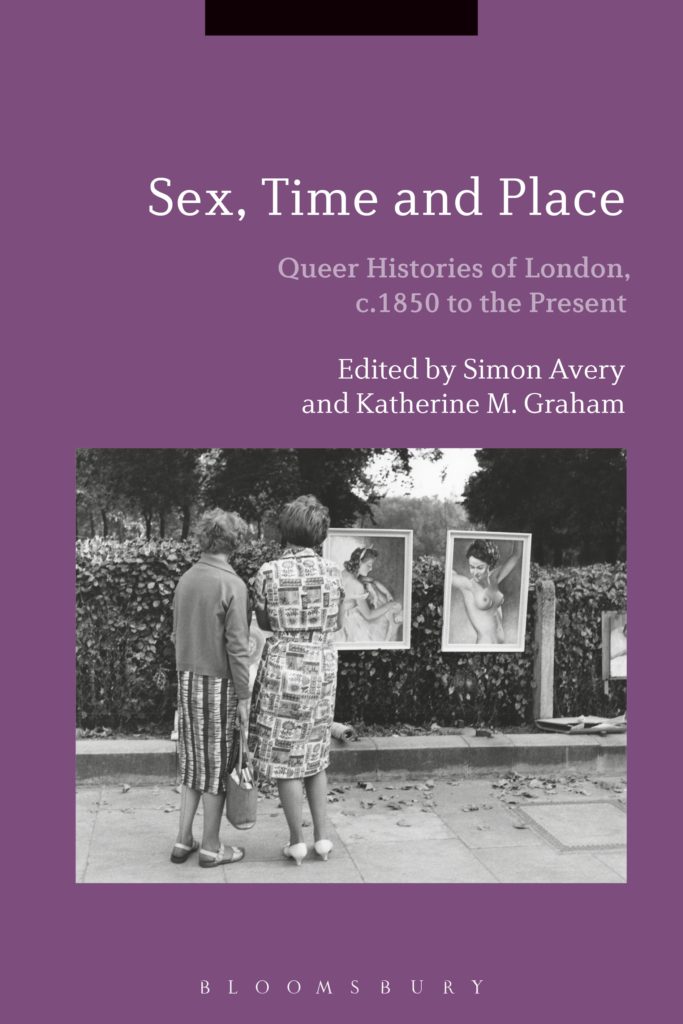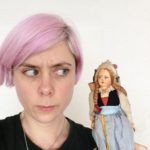Simon Avery and Kate Graham
Sex, Time and Place explores a variety of queer histories of London from c.1850 to the present, with contributions from 15 academics working in a range of different disciplines. When we started thinking about putting the volume together, we were particularly keen to try to build upon existing studies that focus principally on the experiences of gay men – for example, in the fantastic work by Matt Cook, Matt Houlbrook, and Mark Turner – and to consider what other histories might be out there. So the volume brings together material from social and political history, the history of science and medicine, art history, geography and urban studies, digital humanities and literary/textual analysis, and starts to uncover histories of the experiences of lesbians and queers of colour alongside those of middle and working-class gay men. Two introductory chapters – one by each of us as editors – seek to frame these analyses by considering theories of queer space and queer temporality more widely.

NOTCHES: What drew you to this topic, and what are the questions you still have?
Simon Avery and Kate Graham: In March 2013, we organised a one-day conference on the general topic of Queer London at the University of Westminster, which had its roots in discussions we’d been having in various pubs in Soho and in the suburbs about our perceptions of the relations between queer space and gender. We were struck by the range and quality of abstracts submitted for the conference, and the day was full of exciting debate and dialogue around aspects of Queer London’s histories – and, indeed, what might be thought to constitute queer London. As a direct result, we went on to establish the Queer London Research Forum, based in the School of Humanities at the University of Westminster, so we could continue these discussions, and worked to put together the Sex, Time and Place volume with Bloomsbury.
We were really pleased with the volume, but like all academic work it opened up further questions and avenues for investigation. For Kate, these centre particularly on how the city might facilitate queer experiences of temporality; and for Simon, they centre on debates about queer space as they’re reflected in writing from the second half of the nineteenth century. These are key areas that we’d like to pursue further.
NOTCHES: The book is clearly about the history of sex and sexuality, but what other themes does it speak to?
Avery and Graham: The collection ranges widely through discussions on the intersections between sex, sexuality and issues such as space, time, gender, class, ethnicity, and nationality. Because of the different disciplinary approaches adopted by the contributors, the volume is also concerned, explicitly or implicitly, with ideas of methodology – how we ‘do’ queer history and how it might be constituted in multi- and interdisciplinary terms.
NOTCHES: How did you research the book? (What sources did you use, were there any especially exciting discoveries, or any particular challenges, etc.?)
Avery and Graham: The research for the book came initially out of the conference and the astonishing work which our individual contributors undertook with a range of disciplines and approaches. From oral history interviews to analysis of art works, the assessment of physical and digital archives to the reading of diaries and medical documentation, the methodologies deployed were insightful and innovative.
One of the key challenges for us as editors was how to arrange the material so that the connections were drawn out but in a way which resisted an artificial and erroneous progressive narrative. In putting the chapters together, then, we avoided theme and chronology as ordering principles and instead attempted to arrange the material in ways which facilitate dialogue across disciplines, spaces and times and thereby attempt to encourage different synergies. Many of the contributors have brought previously ignored or marginalised historical moments or figures into view, asking us to revisit what queer London might actually mean and what is at stake in these definitions.
Another challenge was the idea of ‘queer’ itself. In a smart move, our editor at Bloomsbury asked us to invite each contributor to define how they were using ‘queer’ in their chapter. As you can imagine, this resulted in a range of definitions and approaches, which served to highlight both the vitality and some of the critical problems of queer as a theoretical framework. So on one level, too, the volume raises questions about the uses of queer in a variety of contexts, something that several reviewers of the volume have noted.
NOTCHES: What stories or what topics were left out of your book and why? What would you include had you been able to?
Avery and Graham: One of the many exciting things about putting this volume together was the increasing awareness of how much work there still is to do. The complicated histories of female same-sex desire in London still need far more attention, for example, as do the complex experiences of queers of colour. The chapters by Anne Witchard (‘Sink Street: The Sapphic World of Pre-Chinatown Soho’) and Gemma Romain and Caroline Bressey (‘Claude McKay: Queering Spaces of Black Radicalism in Interwar London’) have opened up some fascinating lines of enquiry in these areas, on which future work could build. Similarly, as Martin Dines’ thoughtful and generous review of the collection suggests, much more attention needs to be paid to queer experiences in London’s suburbs. So there’s plenty more areas to keep investigating!
NOTCHES: Did the book shift significantly from the time you first conceptualized it?
Avery and Graham: Probably not as much as most books do because we pretty much knew what the individual chapter writers were going to contribute. That said, there were some great developments from contributors’ original conference papers to the final essays submitted given the space for detail and theoretical thinking available. Probably where the volume shifted most was in our sense of how we ordered the material, in our attempt to avoid a simplified chronological narrative that suggested that queer experiences in London are underpinned by a clear trajectory of progress. Obviously this is far from the case and in choosing to put historically diverse essays next to one another we sought to reflect that and gesture towards connections and differences across various times and spaces.
NOTCHES: How did you become interested in the history of sexuality?
Graham: My interest in the history of sexuality began when I encountered Lillian Faderman’s Odd Girls and Twilight Lovers, became a fascination with Foucault’s The History of Sexuality, and then became an obsession when I read Carolyn Dinshaw’s Getting Medieval.
Avery: I mostly work on literature and culture of the long nineteenth century and have been interested for a long time in the ways in which writers and artists of that period deal with questions of desire. From the Brontës to Beardsley, Wordsworth to New Women Writers like Ménie Muriel Dowie and Sarah Grand – you can feel throughout the century a constant restlessness in searching for a language and form with which to express what desire is and how it’s structured in social and political terms, and I’ve always found that fascinating. More recently, and especially since the work on Sex, Time and Place, I’ve been increasingly interested in how nineteenth-century texts examine the complex relations between queer desires and space, and how these connect to larger histories of sexuality.
NOTCHES: Why does this history matter today?
Avery and Graham: Obviously our understandings of the past and their relations to the present are constantly shifting and the histories which the contributors to this volume have started to uncover – whether those of the mid-nineteenth century or far more recent times – raise crucial and probing questions about structures of power, exclusion, (in-)visibility, and the intersections between sexuality, gender, class and race. These questions clearly haven’t disappeared in our own time, although they might have modulated into slightly different forms. Equally important, though, is our developing understanding of how we undertake queer history – what methodologies we might deploy, what constitutes ‘evidence’, and the place of the archive in this (and also what an archive might be). These questions about process seem to matter as much as what is uncovered.
NOTCHES: Your book is published, what next?
Graham: Since publishing Sex, Time and Place, I’ve been focused on the early modern thread of my research. In particular, my work has focused on revenge and how, in early modern theatre, revenge might be seen to intersect with ideas around queerness, temporality, strangeness and anger – I’ve got a number of book chapters and journal articles interrogating these relationships in print or forthcoming. I’ve also been developing two new Theatre Studies degree programmes for the School of Humanities, which begin running in September 2018. And of course we’ve been running a number of really exciting events under the auspices of the Queer London Research Forum. We’ve been lucky enough to host Chinese documentary filmmaker Popo Fan, early modern scholar Professor Stephen Guy-Bray, and trans poets and authors Roz Kaveney and Rachel Mann and we’ve also run events discussing queer sports, Soho, and London’s drag scene.
Avery: I’ve returned to my other key research interest, nineteenth-century women’s writing, for a bit whilst I’m working on a book on the Brontë family and politics. The political interventions that literary texts can make – whether explicitly or covertly, in more radical or more conservative shifts – is one of the several ways in which this work connects to my interest in queer histories. After this book, I want to return more to ideas around queer space and as Kate says, we’ll be continuing to hold events through the Queer London Research Forum. Our forthcoming conference on the Cleveland Street Scandal will, in part, be linked to this interest in queer space.
 Simon Avery is Reader in Nineteenth-Century Literature and Culture at the University of Westminster and Co-Director, with Katherine M. Graham, of the Queer London Research Forum. His research interests include the relations between nineteenth-century literature, politics and gender; historiography and queer histories; and the 1890s. He is currently working on a book about the Brontës and politics.
Simon Avery is Reader in Nineteenth-Century Literature and Culture at the University of Westminster and Co-Director, with Katherine M. Graham, of the Queer London Research Forum. His research interests include the relations between nineteenth-century literature, politics and gender; historiography and queer histories; and the 1890s. He is currently working on a book about the Brontës and politics.
 Kate Graham is Senior Lecturer in English Literature (Theatre) and Course Leader for the BA Theatre Studies & English Literature and Theatre Studies & Creative Writing at the University of Westminster. She is co-director of the Queer London Research Forum, which she runs with Simon Avery and which was established in 2013 to investigate London’s queer histories, from the mid-1800s to the present. In 2011 Katherine was a Visiting Scholar at the Centre for the Study of Gender and Sexuality at New York University.
Kate Graham is Senior Lecturer in English Literature (Theatre) and Course Leader for the BA Theatre Studies & English Literature and Theatre Studies & Creative Writing at the University of Westminster. She is co-director of the Queer London Research Forum, which she runs with Simon Avery and which was established in 2013 to investigate London’s queer histories, from the mid-1800s to the present. In 2011 Katherine was a Visiting Scholar at the Centre for the Study of Gender and Sexuality at New York University.

NOTCHES: (re)marks on the history of sexuality is licensed under a Creative Commons Attribution-NonCommercial-NoDerivatives 4.0 International License.
Based on a work at www.notchesblog.com.
For permission to publish any NOTCHES post in whole or in part please contact the editors at NotchesBlog@gmail.com




